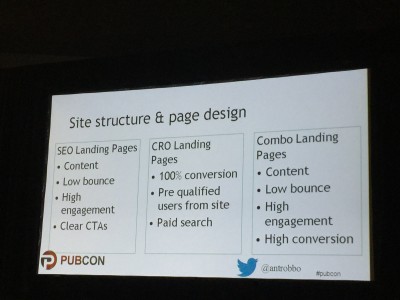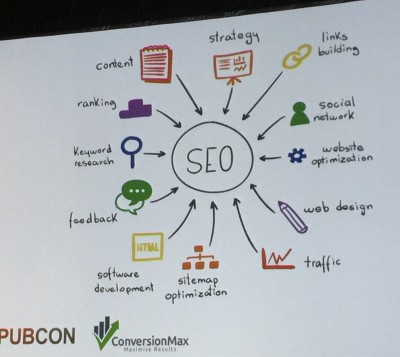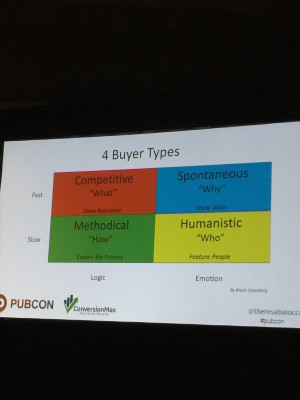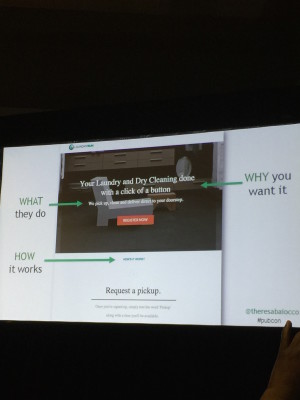Intersection of SEO and CRO – Ant Robbinson @antrobbo
Ant jumps off the stage and prowls around the front as he talks. He has a low voice but very compelling and the accent is always fun. He jumps right in.
Are we adding value to the bottom line? If we can’t prove that we have, then we can’t demonstrate value. Reports must be “tied to business goals”. We have to monetize our landing pages. Once we can find someone in the business to figure out that average annual revenue per landing page, it helps with management.
Whoops, change of microphones and he’s happier. We are too, we can hear better!
It doesn’t matter how good your conversion rate is, if your traffic goes down, you die. So going back to that mid level finance exec to validate the page, we can go back to management and protect it. If the brand police want to change something, or the developers jump in and ruin something.. suddenly the value is gone. If the CFO understands the value of what we do, we get our sign-offs on everything that goes live.
Referring to the Moz Whiteboard Friday – it’s a great read.
Moving on to SEO. Evolve: Deliver better value. SEOs need to intersect with CRO, paid, and social.

- Balance is the key
- Content still needs to attract editorial links
- Page layouts need to be flexible based on user journey/intent
Art brings up an example on the screen. The keyword is “Golf Holidays Portugal” where they move the content up higher to show better and work with SEO but also work with the page CRO values.
Art uses SEOMonitor – Promo code PureAntSEO (30 days free instead of 14 days)
Deep Crawl & VisualWebsite Optimizer.
And he’s done!
Our lovely moderator comes up in the awesome green hat (I want one) and introduces Theresa Baiocco-Farr. She’s been teaching CRO for some time along with a laundry list of other awesome things.
She successfully walks down steps in heels in front of a crowd. Success! Is this the new thing where they come down to walk down in front of us? I like it. Makes it more warm and fuzzy.
She starts talking about all the experts we are hearing from. We have to use our judgment and what makes sense for us. Compliments the English accent and says it will be hard to follow!
But he’s right, we have to combine SEO and CRO and work on both. Theresa is going to take CRO one step further. She uses the comparison of a fishing boat bringing in a disgusting load of garbage and fish. Same thing for your website. If the traffic is not right, it’s not going to work for you.
Get your fishing net to work for you. Your visitors, your data, your website’s evolution.

How does your site make money? Traffic x CRO (Conversion rate optimization) = Value
Traffic is earned traffic from SEO or social. Or, you can have paid traffic.
Find those problems and then fix them.
That equals money. Your ecommecer order or value of a lead. Cross sells, upsells, repeat purchases, referrals.
4 Common Mistakes
– Looking for a quick fix.
– Improving UX and CRO to please Google. You improve your conversion rates to make money. Google is a secondary benefit.
– Working on cheap traffic. Change your mindset, to make the traffic that you have worth more.
– Launching a new version of your website every X years. It no longer works. Theresa brings up FinishLine, the shoe company. The wanted a more modern look. Terrible look with someone’s face on the front. They sell shoes. They lost 3M over the holidays.
To avoid those common mistakes, focus on your sites visitors. Most overlooked aspect, in Theresa’s opinion.
Visitors: Strive to understand your site’s visitors first.
Don’t be afraid to repel the wrong people. You become more attractive to the right people.
Data: Gather, qualify, and quantify data for winning tests.
That way you can fix them.
Evolution: Use test results to evolve site (ESR)
If you do this, you will definitely get love from the Google Gods. But consider that icing on the cake.
Theresa says you have to understand there is a person with a problem. Explain how you are the solution. What is your USP (unique selling proposition).
These four places can combine what we can do for someone and why they should choose us:
Headline
Sub-Headling
Tagline
Hero Shot
I have no idea what a hero shot is?
She shows off LaundryRun – We analyze a few examples. WHAT they do, and WHY? With a click of a button. It gets 3 out of the 4 buyer types. With a very simple page.
Most websites aren’t good at answering that WHY. What makes us different from competitors?
She recommends the “User is Always Right” book which I missed the author!
That wraps up #1 which is understanding your visitors. Now it’s about data. Analytics, that shows you the WHAT but not the WHY. So we move to qualitative data. She loves UserTesting.com which I do recommend, we have used it a lot. It’s hysterical how they talk out loud to show you what they like or don’t like about it. For me, it only has so much value though.
UserTesting: 3 free tests! Discount code: Conversion2016
That’s pretty awesome. Hopefully it’s for old users too 🙂 Theresa says it’s painful. That is true. It really does help you when you are making those big changes.
She also likes the “five second test” by UsabilityHub. Again, WHAT can we do for people and WHY should they choose us in the first five seconds. It’s random anonymous people looking at the page. Then they answer the questions.
“What do you think this company sells?” is the first question she always likes to ask. You have to download the raw file though because she found 25% of people who had no idea and thought it was something else. There was a book on the front page in the background. She changed it out, and got a 25% improvement. She collected more data, came up with a new hypothesis, got a new test.. and got ANOTHER 25% lift. That is what CRO is about.
You need a full time person for this. I think, anyway!
Question from the audience, what was Theresa measuring? Bounce Rate.
The homepage is what convinces people to stick around. To actually make money, she moved on to their lead gen (form) page. She looked up a heat map to see what was drawing their attention. If you want people to fill out the form, maybe the form should stand out a bit.
She did a bunch of things (changed questions, different colors, moved things around) and got a 71% lift.
It’s not just testing button colors.
There were a few logos on the side that quickly disappeared. LuckyOrange, HotJar, and CrazyEgg were the first three.
If you are constantly testing, evolving, and changing, you will stay on top of those best sites in your industry.
Traffic: 10,000 visitors a month
CR: 2%
VC: $500
= $100,000 a month
Take that conversion rate up to 4%, doubles to $200,000.
I love easy math.
Theresa says they should give a nice little bonus to your conversion person. You should also put that money back into your business. Keep evolving. Then you go back to your traffic and it makes it even better.
Theresa is challenging us to do something when we get back to the office. What are those tricks? Chasing the google updates? Praying to the Google Gods? Think differently and make a change.
Theresa leaves her Twitter handle for questions @theresabaiocco
Kenny (I got his name!), our green hat moderator showed back up to say “Start somewhere!”. He brings up how Facebook is always different and testing. Let’s hear it for questions… There are a few hands up.
Q – Returning clients on an e-commerce site. Lower cost traffic.
A – From Theresa, she did a conversion audit for a client. Their service was something that had returning clients but the data showed the traffic was low. The conversion rate was high for those though. The competitor seemed to be doing better with loyalty programs and capturing emails. There was a reason to create an account and there was GOOD stuff to do once you had that account. She recommended that loyalty program, where you couldn’t test it, but that would help.
Ant takes the mike to talk about… something, I’m hypnotized by his accent a bit. The retention strategy focuses on the customer lifetime value of the client. Strategies such as email… need to be clever. Also off-site activity such as remarketing. That will help.
Q – About the heat mapping tools, some of them sounded like they were not tracking mouse, eyes, etc. How does that work?
A – The first slide that predicted where the eye went, doesn’t go over that. The second one did (slides are available after). Those do measure where they are clicking and scrolling. Theresa has no idea how they work! An audience member is saying they track pixels. Theresa starts talking about putting tags on people, who abounded and then see what they do. You want the story and the pattern. Useful and affordable.
Q – You talked about a tool that was better than Screaming Frog?
A – It’s on the slide (I also wrote it up at the top). Ant doesn’t even like to look at the site sometimes.
Q – One of the things we struggle with is paranoid fear to implement the scripts that might slow down the site. Do you feel like that happens, and any recommendations?
A – Theresa says hide it behind a tag management system. You can take them off and on all the time. Ant says use Google Tag Manager.
Q – More compliments, great session. Guidance or autonomy to the design team or UI.
A – It depends on how good your math is? If you can create a good hypothesis on what you want to test, bring it to the design team. No, he doesn’t trust them… don’t give them free reign. Get that design and hypothesis and then you test it. Theresa agrees as she has clashed with the design team. She will create the wireframe in black and white, get full control over everything and THEN pass it to the designer and suggest brand colors and font from the CSS. There has to be a pecking order of who is in charge of how the page gets launched.
HIPPO – Highest paid person’s opinion – unless you go in there with empirical data to remove their opinion… you need that data. When you can show that result has occurred, you learn from it working or not working.
Q – How do you structure your relationships with your clients?
A – Ant takes them for a 12 month agreement. He likes to know who they are and they need the time and money to spend on this to evolve, then it’s not worth it. Theresa gives an audit.
Q – Tips on mobile design? The eye tracking tools are focused on desktop.
A – No, they do for mobile too but that’s a whole other session. Theresa does a lot of lead gen, how do you get our click to call? Sticky notes or headers? She wants to do that next year. Ant says ecom, says research is done on mobile, but conversion is done on desktop. He doesn’t tend to do a lot on mobile since it doesn’t convert.
Q – Kenny has a question about PPC and analytics, there are a couple of different common types of leads and calls.. but with SEO, you have pages that are not tied to the money. So where do you do technical optimization, what are the top two things you look at for site performance.
A – Ant says reading between the lines, for him the largest important factor is a clear defined website structure on where that user journey should be. You are bringing them in from SEO and PPC and the creative will be different depending on the stage of that user. Where they are in that research journey.
Q – We have a lot of FAQ pages, her boss thinks they are worthless. She wants to capitalize.
A – Theresa LOVES FAQ pages. Answer them all and then send them somewhere. Get them further down their research stage. You can quickly establish their intent, says Ant, if they are high bounce, get a better call to action. Use those FAQ pages as a means for remarketing.


Comments on this entry are closed.